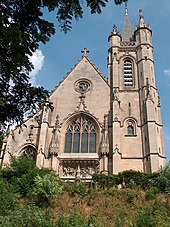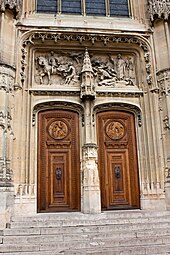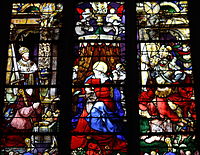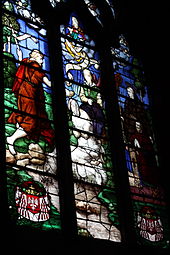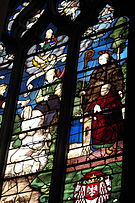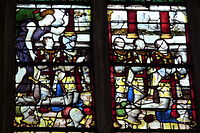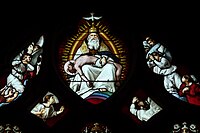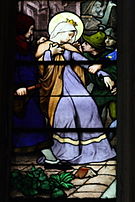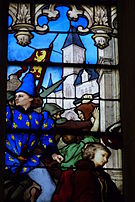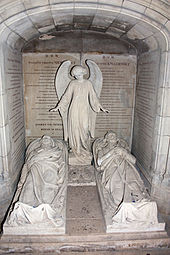St-Martin (Montmorency)
The Catholic parish church of Saint-Martin in Montmorency , a parish in the Val-d'Oise department in the French region of Île-de-France , dates back to a collegiate church from the 12th century. The current church was built in the 16th century in the Flamboyant Gothic style. The church is worth seeing because of its stained glass windows , 14 of which have been preserved from the Renaissance . In 1840 the church was added to the list of architectural monuments in France as Monument historique .
history
The Canons' Monastery was probably founded in the 12th century by Mathieu I of Montmorency and was intended to serve as a burial place for the Lords of Montmorency . Since he already 1,132 canons appointed, the church at that time must have passed. From this first church nothing remains except two columns and a few capitals , which are now kept in the Louvre Museum in Paris . In 1270 Mathieu IV of Montmorency had the church rebuilt. The current church was started around 1515 under Guillaume de Montmorency, father of Anne de Montmorency , the first Duke of Montmorency . In 1521 the carpenter Michel Langogne made the roof structure, which has been preserved to this day. When Guillaume died in 1531, the apse and the four eastern bays were completed, as were the north portal and the turret. Not until 1558 was Anne de Montmorency, 1538 for Constable collected and since 1551 Duke of Montmorency build the nave, which was completed 1563rd The architect Jean Bullant , who designed the Chantilly and Écouen castles in the Renaissance style for Anne de Montmorency , was entrusted with the construction management and had instructions to continue the Gothic style of the choir in the nave. Jean Desilles was responsible for the execution. With Anne's death in 1567 the construction work ended, the facade and the bell tower were not carried out. In the middle of the nave, the splendid tomb of Anne de Montmorency and his wife Madeleine de Savoie was erected, of which nothing is preserved in Montmorency today. The marble reclining figure of Konnetabel is now in the Louvre Museum in Paris. Anne de Montmorency's successors could no longer be buried in the church. In 1617 Henri II of Montmorency gave the church to the Oratorians , who took the place of canons. The church was also used as a parish church.
During the French Revolution , the church was looted, the graves profaned and the noble coats of arms smashed in the windows. An extensive renovation of the building took place from 1875 to 1910 under the direction of the architect Lucien Magne . Another sacristy was added, and the bell tower and west facade were built in the neo-Gothic style. The Renaissance windows have been restored and partially supplemented. In the western yokes of the nave, the previously white windows have been replaced by lead glass windows.
architecture
Exterior construction
The north portal was the only access to the church until the end of the 17th century. It dates from the 16th century, the oak doors are decorated with figures, masks, putti and fantasy creatures. A large tracery window opens above the portal .
The outer walls are structured by buttresses , which are decorated with fantasy creatures on the south side. In some cases niches have been cut that were originally occupied with figures of saints. The apse is broken up by large, nine-meter-high pointed arched windows.
In the south of the west facade rises the 42 meter high, neo-Gothic bell tower. The west portal is decorated with two reliefs by the sculptor Hippolyte Lefèbvre . They were installed in 1909 and depict St. Martin sharing his cloak with a beggar and having a pagan tree felled. The middle of the west facade is occupied by a large, four-lane, Gothic-inspired tracery window.
inner space
The nave has three aisles , the central nave opens into a choir with a polygonal end in the east. A transept there is not.
The coats of arms of the Montmorency and Pot families can be seen on the keystones of the choir . Guillaume de Montmorency, who had the choir built, was married to Anne Pot. The keystones of the ship bear the coats of arms of Anne de Montmorency and his wife Madeleine de Savoie. The year 1563 can be read on one keystone and the motto of Anne de Montmorency APLANOS on another .
Leaded glass window
Renaissance window
The oldest leaded glass windows are in the choir and the eastern yokes of the ship. Twelve windows were created between 1524 and 1545, the two windows by Anne de Montmorency and his wife are from 1563.
- Middle choir window (window 0)
|
The central choir window shows the year 1524. It was restored by the stained glass Ména in Paris in 1860. In the lower fields Jesus and Mary are depicted, above the two patron saints of the church, St. Martin and St. Felix. St. Dionysius of Paris and St. Leonhard can be seen in the upper fields . |
- Window by Guillaume de Montmorency (Window 1)
|
The left choir window depicts Guillaume de Montmorency kneeling next to his five sons. Behind Guillaume stands William of Aquitaine , behind his sons the Archangel Michael . On the panes above you can see the apostles Peter and Paul and at the very top St. Theobald and St. Jerome . |
- Anne Pot's Window (Window 2)
|
Anne Pot was the wife of Guillaume de Montmorency. She is shown with her three daughters and the patron saints, St. Anne and St. Catherine . In the middle Mary Magdalene and St. Martha can be recognized, above St. Barbara and St. Genoveva . Most of the window was renewed in 1861. |
- Window of the young Anne de Montmorency (window 3)
|
On the window Anne de Montmorency is shown as a young man. He kneels in front of a Madonna and Child, with Saint Barbara standing behind him. |
- Window by François de Rochepot (Window 4)
|
François de Rochepot was the son of Guillaume and the brother of Anne de Montmorency. On the right the founder kneels in front of Françoise d'Amboise , the left side shows the scene of the Lamentation of Jesus with Mary and John. |
- Window by Anne de Montmorency and Guy de Laval (Window 5)
The three-lane window was designed by Anne de Montmorency, sister of the Konnetabel of the same first name, and her husband Guy XVI. de Laval donated. The two lancets on the left depict the donors with their two patron saints, St. Anne, who teaches Mary how to read, and St. Jerome. The right lancet shows Mary Magdalene under the cross.
- Window by Marie-Louise de Montmorency and Gaspard de Coligny (window 6)
|
Marie-Louise was the eldest daughter of Guillaume de Montmorency. She and her husband Gaspard de Coligny were the parents of Huguenot leaders Gaspard II and Odet de Coligny . The window was largely renewed in the 19th century. Gaspard de Coligny is under the protection of the Archangel Michael, behind his wife is the French King Louis the Saint . |
- Window by Charles de Villiers de l'Isle-Adam (Window 7)
|
Charles de Villiers de l'Isle-Adam was a cousin of Anne de Montmorency and, as Bishop of Beauvais, held the title of Peer of France . The window was made by the glass painter Engrand Leprince from Beauvais . In the background of the bishop is Charlemagne , the painter, the trains of the Emperor Charles V gave. The middle lancet shows a Madonna and Child, on the right you can see St. Hadrian. In the window of the tracery, 13 medallions with the heads of warriors in grisaille technique are inserted. The coats of arms in the lower panels are the only ones that were not smashed during the French Revolution. |
- Window by Guillaume Gouffier (Window 8)
Guillaume Gouffier was married to Philippe de Montmorency, a sister of Guillaume de Montmorency, for the second time. On the window is the founder with his six sons and the Saints Wilhelm of Aquitaine , Adrian of Nicomedia and Benedict of Nursia .
- Window by François de Dinteville (Window 9)
|
François de Dinteville was Bishop of Auxerre . He is the only benefactor who does not belong to the Montmorency family. On the left lancet, François de Dinteville kneels in front of his patron saint, St. Francis , who bears the wounds of Christ. In the middle, St. Christopher is depicted, on the right lancet St. Stephen , the patron saint of Auxerre Cathedral . |
- Window of Odet de Coligny (Window 10)
|
Odet de Coligny , also known as Cardinal of Châtillon, was the son of Gaspard I. de Coligny and brother of Gaspard II. De Coligny. He later became a leader of the Huguenots. On the window he is shown kneeling in the traditional Catholic way before his patron saint, St. Odo von Cluny . The middle and right lancet shows the baptism of Jesus. |
- Eagle window (window 11)
|
The so-called eagle window is named after the many representations of eagles or Alérions , the heraldic animals of the Montmorency family. Of the four holy women in the lower fields, Maria Salome and Maria Magdalena are copies from the 19th century. Only Maria Kleophae and Martha date from 1525. |
- Madeleine de Savoie's window (window 12)
|
On the south side of the nave, opposite the window of the Konnetabel Anne de Montmorency, is the window that originally contained the portraits of his wife and her seven daughters. Only the depictions of the daughters have survived. In the upper scenes one can see an Adoration of the Shepherds, Saint Barbara and Saint Agathe . |
- Window of Anne de Montmorency (Window 13)
|
Anne de Montmorency had the window done in 1563 after the building work on the nave was completed. On the lower fields the Konnetabel and his five sons kneel, protected by the Archangel Gabriel and St. Anne, who teaches Mary how to read. At the top right you can see a Madonna and Child, in the middle John the Baptist and left John the Evangelist . |
19th century window
The windows of the four western bays were installed in the late 19th century. They were created by the glass painter Charles Leprévost after boxes by François-Émile Ehrmann . They are designed in the style of the Renaissance windows and represent descendants of the Montmorency family.
- Window of Henri de Montmorency, Louise de Budos and their three sons (window 14)
|
Henri I. de Montmorency was the second son of Anne de Montmorency. He kneels next to Emperor Heinrich II. Bamberg Cathedral can be seen in the background . Louise de Budos was Henri's second wife, with Louis the Saint standing behind her. The sons are protected by the Archangel Raphael . The mercy seat is shown in the tracery . |
- Window by François de Montmorency and Diane de France (Window 15)
|
François de Montmorency was the eldest son of Anne de Montmorency. He was married to Diane de France , an illegitimate daughter of the French King Henry II . The scene in the background, Louis XI. wants to force Françoise d'Amboise to marry, recalls the marriage of his daughter Diane to the second Duke of Montmorency, forced by Henry II. |
- Window of François III. de La Tour d'Auvergne and Éléonore de Montmorency (window 16)
|
Éléonore was the eldest daughter of Anne de Montmorency. She is represented with Pope Leo the Great , her husband with St. Francis. The two children are entrusted to St. George . The son Henri was the father of the famous general Henri de La Tour d'Auvergne . |
- Window of Louis III. de La Trémoille and Jeanne de Montmorency (window 17)
Jeanne was the daughter of Anne de Montmorency, her husband came from the noble family La Trémoille . Jeanne is shown with their daughters, Louis with their sons. In the middle lancet, Saint Louis presents Christ's crown of thorns .
- Window of Henri II de Montmorency and Maria Felicia Orsini (window 18)
|
Henri II. De Montmorency was the fourth Duke of Montmorency and the last direct male descendant of Anne de Montmorency. He was married to Maria Felicia Orsini for the second time . After participating in an uprising against Cardinal Richelieu , he was sentenced to death and executed. Since he died childless, his sister Charlotte-Marguerite became Duchess of Montmorency. The donors are shown on the two right lancets. The left lancet is occupied by a Madonna standing on the crescent moon and holding the crown of thorns in her hand. |
- Window of Henri II de Bourbon and Charlotte-Marguerite de Montmorency (window 19)
The window shows Henri II. De Bourbon and his wife Charlotte-Marguerite de Montmorency , who became Duchess of Montmorency after the execution of her brother Henri II. De Montmorency. Her eldest son Louis II. De Bourbon is shown on the left , and the other two children Anne Geneviève de Bourbon-Condé and Armand de Bourbon in the middle .
- Window by Henri de La Tour d'Auvergne (Window 21)
Henri de La Tour d'Auvergne was the grandson of François III. de La Tour d'Auvergne and Éléonore de Montmorency. He was Maréchal de France and conquered the Palatinate, which he devastated , in the battle of Sinsheim for the French King Louis XIV . On the left lancet, Henri de La Tour d'Auvergne is shown with Emperor Heinrich II, who is holding Bamberg Cathedral in his arms. The left lancet shows an allegorical representation of virtus , bravery, underneath the general's coat of arms.
Tracery windows of the west facade (window 20)
The large tracery window on the west facade was executed in 1908 by the glass painter Félix Gaudin from a cardboard box by Eugène Grasset . The theme of the window is the Battle of Bouvines in 1214.
Furnishing
- The wood-carved choir stalls were created in the 16th century.
Tombs
- Of the numerous tombs of the Montmorency family, the black marble grave slab for Guillaume de Montmorency and Anne Pot has been preserved.
- The grave slab of the Canon Jean David, who died in 1536, is also preserved.
Monuments to Polish nobles
After the November uprising of 1830/31, many Polish nobles found refuge in Montmorency. She is remembered by several monuments in the church:
- Cenotaph for Karol Kniaziewicz
- Cenotaph for Julian Ursyn Niemcewicz
- Bust of Adam Jerzy Czartoryski
- Memorial plaque for Maria Anna Czartoryska
- Memorial plaque for Iza Działyńska
literature
- Jean-Marie Pérouse de Montclos (ed.): Le Guide du Patrimoine. Ile-de-France . 2nd Edition. Hachette, Paris 1994, ISBN 2-01-016811-9 , pp. 456-458.
- Dominique Foussard, Charles Huet, Mathieu Lours: Églises du Val-d'Oise. Pays de France, Vallée de Montmorency . 2nd Edition. Société d'Histoire et d'Archéologie de Gonesse et du Pays de France, Gonesse 2011, ISBN 978-2-9531554-2-6 , pp. 212-224.
- Le Patrimoine des Communes du Val-d'Oise . Volume 2. Flohic Éditions, Paris 1999, ISBN 2-84234-056-6 , pp. 689-692.
Web links
- Église Saint-Martin in the Base Mérimée of the French Ministry of Culture (French)
- Leaded glass window in the Base Palissy of the French Ministry of Culture (French)
Individual evidence
- ↑ Stables in Base Palissy of the French Ministry of Culture (French)
- ^ Dalle funéraire de Guillaume de Montmorency et d'Anne Pot in the Base Palissy of the French Ministry of Culture (French)
Coordinates: 48 ° 59 ′ 5.9 ″ N , 2 ° 19 ′ 9.1 ″ E

